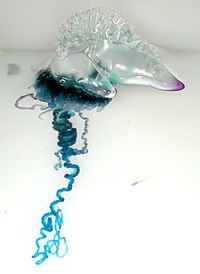
Photo from wikipedia
BACKGROUND AND OBJECTIVE Choosing the most appropriate denoising method to improve the quality of diagnostic images maximally is key in pre-processing of diffusion MRI images. Recent advancements in acquisition and… Click to show full abstract
BACKGROUND AND OBJECTIVE Choosing the most appropriate denoising method to improve the quality of diagnostic images maximally is key in pre-processing of diffusion MRI images. Recent advancements in acquisition and reconstruction techniques have questioned traditional noise estimation methods favoring adaptive denoising frameworks, circumventing the need to know a priori information that is hardly available in a clinical setting. In this observational study, we compared two innovative adaptive techniques sharing some features, Patch2Self and Nlsam, through application on reference adult data at 3T and 7T. The primary aim was identifying the most effective method in case of Diffusion Kurtosis Imaging (DKI) data - particularly susceptible to noise and signal fluctuations - at 3T and 7T fields. A side goal consisted of investigating the dependence of kurtosis metrics' variability with respect to the magnetic field on the adopted denoising methodology. METHODS For comparison purposes, we focused on qualitative and quantitative analysis of DKI data and related microstructural maps before and after applying the two denoising approaches. Specifically, we assessed computational efficiency, preservation of anatomical details via perceptual metrics, consistency of microstructure model fitting, alleviation of degeneracies in model estimation, and joint variability with varying field strength and denoising method. RESULTS Accounting for all these factors, Patch2Self framework has turned out to be specifically suitable for DKI data, with improving performance at 7T. Nlsam method is more robust in alleviating degenerate black voxels while introducing some blurring, which in turn is reflected in an overall loss of image sharpness. Regarding the impact of denoising on field-dependent variability, both methods have been shown to make variations from standard to Ultra-High Field more concordant with theoretical evidence, claiming that kurtosis metrics are sensitive to susceptibility-induced background gradients, directly proportional to the magnetic field strength and sensitive to the microscopic distribution of iron and myelin. CONCLUSIONS This study serves as a proof-of-concept stressing the need for an accurate choice of a denoising methodology, specifically tailored for the data under analysis and allowing higher spatial resolution acquisition within clinically compatible timings, with all the potential benefits that improving suboptimal quality of diagnostic images entails.
Journal Title: Computer methods and programs in biomedicine
Year Published: 2023
Link to full text (if available)
Share on Social Media: Sign Up to like & get
recommendations!